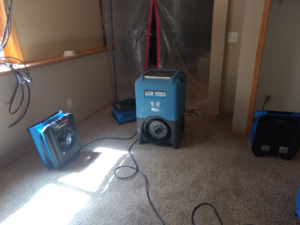
Water damage is one of the most common and costly problems that homeowners face. Whether it’s from a leaky roof, a burst pipe, or a flood, water can wreak havoc on your property, causing significant damage to your belongings and structural integrity. In addition to the immediate damage, water can also create a conducive environment for mold and mildew growth, which can pose health risks to you and your family. That’s where dehumidification comes in. In this blog post, we will discuss the importance of dehumidification in water restoration and why it’s essential to eliminate excess moisture to prevent further damage in Stewartville MN.
What is Dehumidification?
Dehumidification is the process of removing excess moisture from the air to maintain a comfortable and healthy living environment. This is achieved by using a dehumidifier, a device that pulls moisture from the air and collects it in a tank or drains it away. Dehumidifiers are commonly used in homes, offices, and other spaces to reduce humidity levels, prevent mold and mildew growth, and promote healthy indoor air quality.
Why is Dehumidification Important in Water Restoration?
Water damage can cause significant structural damage to your home or business, but the damage doesn’t stop there. The moisture left behind after a water event can lead to the growth of mold and mildew, which can pose serious health risks to you and your family. Mold and mildew thrive in damp environments and can spread quickly, making them difficult to eradicate once it’s taken hold. Dehumidification plays a critical role in Stewartville water restoration by removing excess moisture from the air and preventing mold and mildew growth.
Dehumidifiers can also help speed up the drying process, which is essential in preventing further damage. When a water event occurs, time is of the essence. The longer the water sits, the more damage it can cause. By using a dehumidifier, you can remove moisture from the air and accelerate the drying process, reducing the risk of additional damage.
In addition to preventing mold and mildew growth and speeding up the drying process, dehumidifiers can also improve indoor air quality. Excess moisture in the air can create a breeding ground for bacteria, dust mites, and other allergens, which can exacerbate allergies and respiratory problems. By removing excess moisture from the air, dehumidifiers can improve air quality, making it easier to breathe and reducing the risk of allergies and other respiratory problems.
How to Choose the Right Dehumidifier for Your Needs
Choosing the right dehumidifier is essential to achieve the best results. Here are some factors to consider when selecting a dehumidifier for your water restoration needs:
- Size: Dehumidifiers come in various sizes, so it’s essential to choose one that’s appropriate for the size of the space you need to dehumidify. A small dehumidifier may be suitable for a small room, while a larger one may be needed for a whole house or commercial space.
- Capacity: The capacity of a dehumidifier refers to the amount of moisture it can remove from the air in a day. The capacity is measured in pints, and it’s essential to choose a dehumidifier with a capacity that’s appropriate for your needs.
- Energy Efficiency: Dehumidifiers can be energy-intensive, so it’s important to choose one that’s energy-efficient to save on your electricity bill.
- Noise Level: Some dehumidifiers can be noisy, so it’s important to choose one that operates at a noise level that’s acceptable to you and your family.
Conclusion
Dehumidification is an essential part of water restoration. It helps prevent further damage by removing excess moisture from the air, speeds up the drying process, and improves indoor.
Service Restoration
808 4th Ave SE Stewartville MN, 55976
507-229-7677
